When companies consider implementing technical documentation solutions, one of the biggest obstacles they face is the cost.
Technical writers and knowledge bases cost money, budgets are tight as it is, and, understandably, new investments aren’t easy to justify.
However, what many decision-makers don’t understand is that technical documentation can have a very beneficial impact on a company’s finances.
In this article, we’re bringing you six tangible ways technical documentation can help you generate more revenue and safeguard your budget.
Let’s start with a big one: accelerating time to market.
Accelerates Product Delivery
The way software is developed is becoming less and less sustainable. Accelerating product delivery can have a significant impact on a company's finances. By bringing products to market faster, companies can generate revenue more quickly and gain a competitive advantage. This can result in increased profits, as well as improved customer satisfaction and loyalty.
Faster product delivery can also reduce costs by minimizing the time and resources required for product development and testing. This can lead to cost savings in areas such as employee salaries, facility costs, and equipment expenses. Additionally, reducing the time to market can help companies to avoid potential revenue losses due to competitors launching similar products first.
Developers are faced with extremely tight deadlines that make it almost impossible for them to do quality work and deliver products to the market on time, all the while keeping their sanity intact.

Source: Reddit
The methodology of creating technical documentation seems to be a part of the problem.
That’s because many companies still leave technical writing up to developers instead of hiring professional writers.

Source: Archbee.com
As you can see, more than half of software companies have developers document the product they are working on.
This is problematic because it puts additional stress on developers who are already overworked and often unable to deliver projects on time because of tight deadlines.
Furthermore, developers themselves often remark that they dislike having to write documentation because it’s not their primary job.
Andrés Reales, a senior full-stack software engineer, is particularly vocal about this subject on his blog:
“Many programmers view the task of writing documentation as a necessary evil. After all, it’s often seen as a waste of time that could be better-spent coding. However, for others to use and understand their code, programmers are typically required to document their work, and this can be a tedious and frustrating process.”
Why is this important for a company's finances?
That part is easy. If a product is late to the market because of significant delays, a lot of revenue that could have been realized is missed because the product was still in production.
This missed revenue is calculated as a cost to your company that’s directly caused by the delay in product delivery. Here’s a diagram to illustrate this point:

Source: Pragmatic Solutions
The bigger curve represents the potential revenue that could have been realized had the product been delivered on time.
The smaller one is the revenue that was actually realized after the delay. The difference between them is the cost of delay.
However, when documentation is left to the experts, i.e., technical writers, projects have a much better chance of being completed on time because developers are liberated from writing documentation.
They are able to focus on their primary work, developing the product, which means that the product delivery times are accelerated.
Technical documentation is too important to overlook in the development process. That's why we suggest you to read the importance of technical writing in knowledge management.
However, with technical documentation created by technical writers instead of developers, product delivery times are improved, and less revenue is missed because of delays.
Increases Conversion Rate
When considering the importance of technical documentation, CEOs and executives usually focus on the value documentation has for its existing users, and their ability to use the product successfully. In order to help you, we made a list of the most important technical documents for product managers.
Many still don’t realize that documentation can actually be an extremely powerful tool for attracting and converting new customers. And, for that, Archbee is here to help you to create the best technical documentation possible. You can enroll whenever you want in a product demo or even in a 1:1 onboarding call.
The reason is simple. Modern buyers want to find out for themselves if a product is a good fit for their needs instead of being persuaded into purchasing a product by advertising.
The studies on this are quite unambiguous.
Buyers (especially in the B2B software space) are spending more and more time researching products both online and offline and relying less on advice from suppliers and sales reps.
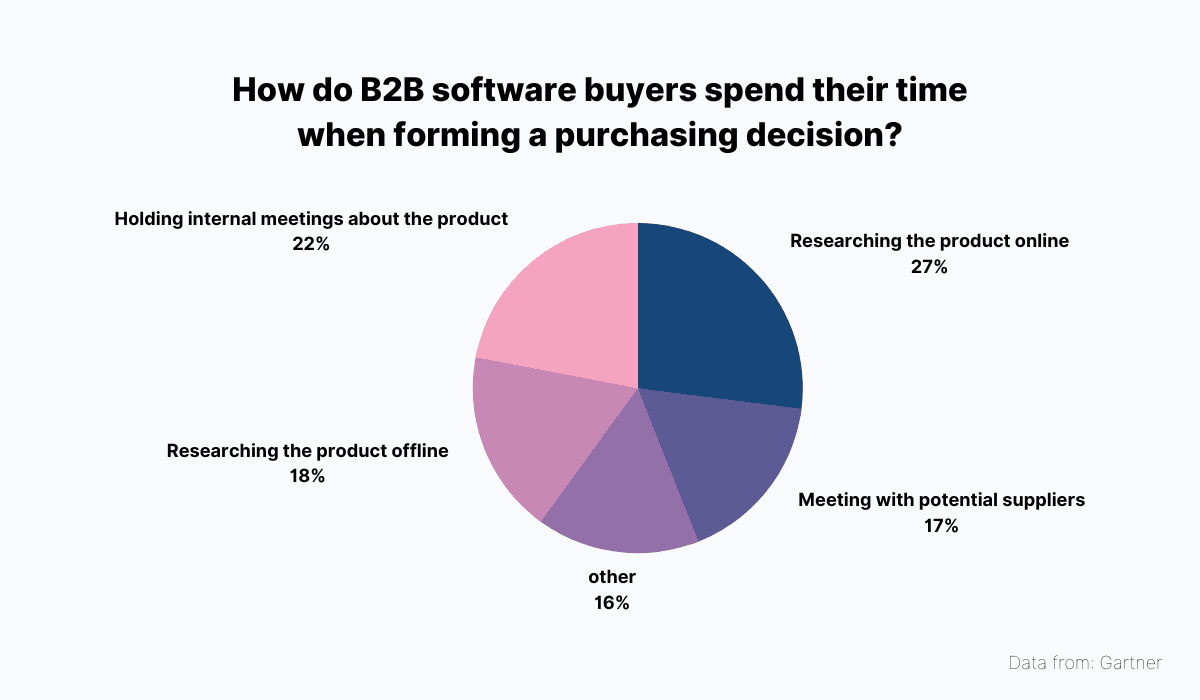
Source: Archbee.com
This research process includes checking unbiased resources buyers believe they can trust when they’re forming their purchasing decisions, such as user reviews, websites, and, yes, technical documentation.

Source: D2 Worldwide
The shift in preferred marketing methods isn’t difficult to explain. Advertising has the explicit purpose of convincing potential customers to buy a product or subscribe to a service.
Its goal isn’t so much to educate and help people as it is to sell products, which is why modern buyers, conscious of advertising tactics, are starting to avoid it.

Source: Twitter
Carefully designed and professionally written technical documentation, on the other hand, isn’t that concerned with selling.
Its primary concern is to teach users how to achieve success using the product. As such, it represents a valuable resource for buyers.
When potential customers turn to technical documentation, they can find out all the information they need to make an informed purchasing decision, such as:
- What are the potential uses for the product?
- How difficult is the product to use?
- How can the product help me improve my work and/or life?
- Which problems am I likely to encounter when using the product?
It, therefore, comes as no surprise that your user guides, FAQ sections, and other resources in your knowledge base can be used for marketing purposes and improve your conversion rates, especially in these times when classic advertising methods just don’t do the trick anymore.

Source: Zapier
Businesses are becoming more aware of this fact and taking advantage of it.
For example, Aaron Fulkerson, founder of MindTouch, Inc., recognizes the strong link between documentation and customer acquisition:
“Online product and services documentation has proven to be an immensely effective way to increase new customer acquisition and to shorten sales cycles.”
Long story short, technical documentation doesn’t just serve your existing customers.
It also helps potential buyers start trusting your offer, which means it has the potential to increase conversion rates and expand your sales efforts.
Improves Customer Retention
Improving customer retention can have a significant positive impact on a company's finances. Retaining existing customers is often less expensive than acquiring new ones, as it typically requires less marketing and advertising spend. Additionally, loyal customers are more likely to make repeat purchases and recommend the company to others, which can lead to increased sales and revenue.
Improving customer retention can also reduce costs associated with customer churn. Losing customers can be costly, as it requires companies to spend resources on acquiring new customers to replace them. This can result in increased marketing and advertising expenses, as well as the potential loss of revenue from those customers.
One of the reasons why the SaaS business model is so innovative is because it doesn’t require its customers to make a big commitment.
Instead of making a large one-time purchase, users are enabled to subscribe to the product and pay as they go, free to cancel their subscription at any time.

Source: Miro
As useful as this is for customers, it can present a challenge for SaaS providers who need to keep making their clients happy even after the initial purchase has been made.
In other words, they need to focus on customer retention and avoid customer churn as much as possible.
From a financial perspective, this is a key goal for SaaS providers because every customer that leaves your service takes with them all the potential revenue they might have brought to the company in monthly or yearly subscriptions.
So, how can technical documentation help here?
The answer lies in the reason why most customers churn from SaaS products. Here are few ideas for minimizing churn.
And that reason is pretty logical if you think about it: software users will abandon the product if they can’t learn how to use it successfully or can’t find value in it.

Source: Archbee.com
However, quality technical documentation can put a stop to all of that.
Resources like Getting Started guides and user manuals are excellent for carrying the customer through their early days with your product until they become a proficient user of the software.
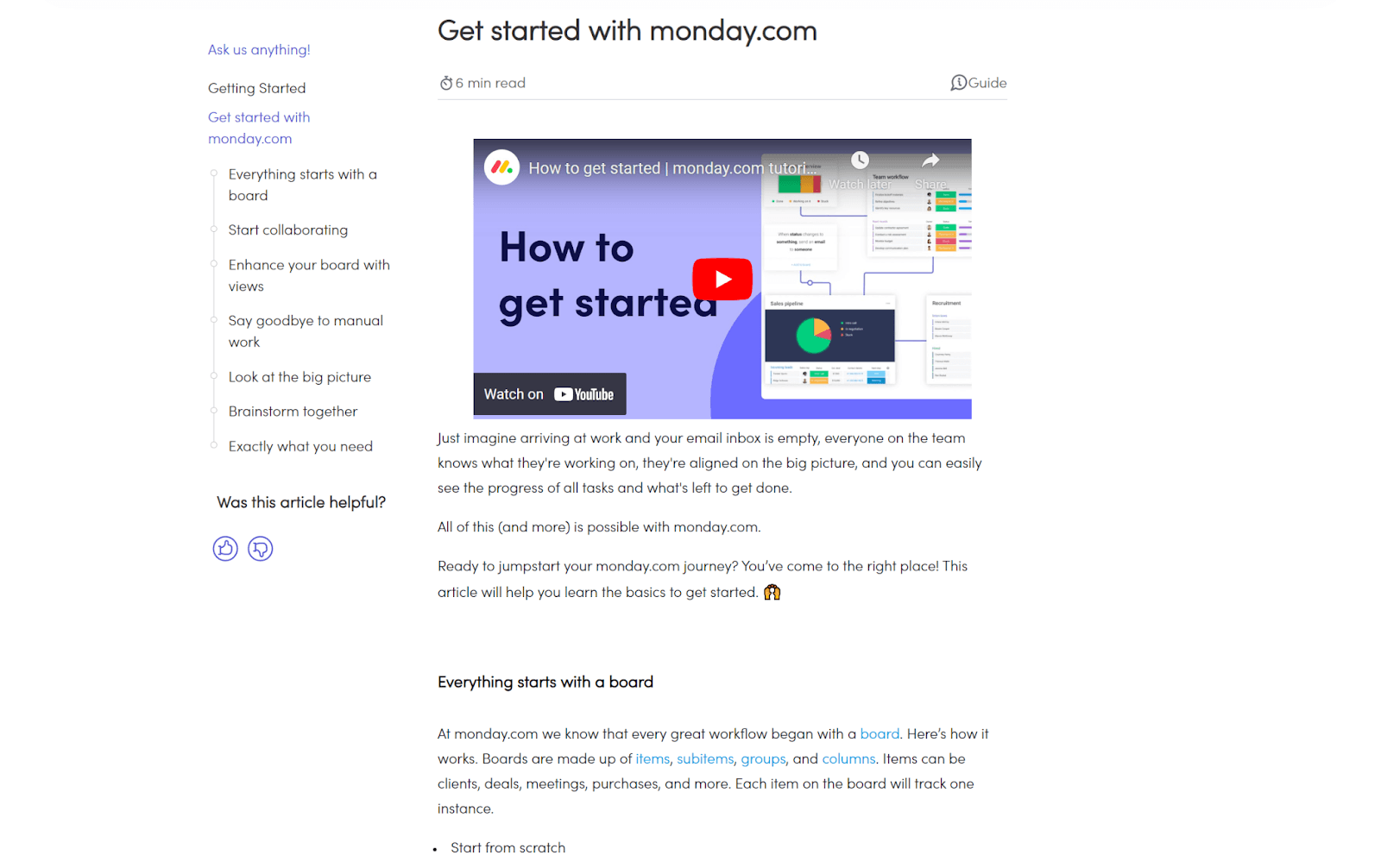
Source: Monday.com
As we said in a previous section, the purpose of technical documentation is to educate users and show them how to successfully use the software, meaning it has the power to eliminate the biggest cause of churn SaaS companies struggle with.
There are case studies to support this bold claim.
For example, Hack the Box, the online cybersecurity training platform, had a problem with users not understanding how to navigate the features of their complex service.
Their solution was to implement an online knowledge base that guides users through every feature of the platform so that they could learn to achieve their goals on their own and feel supported every step of the way.
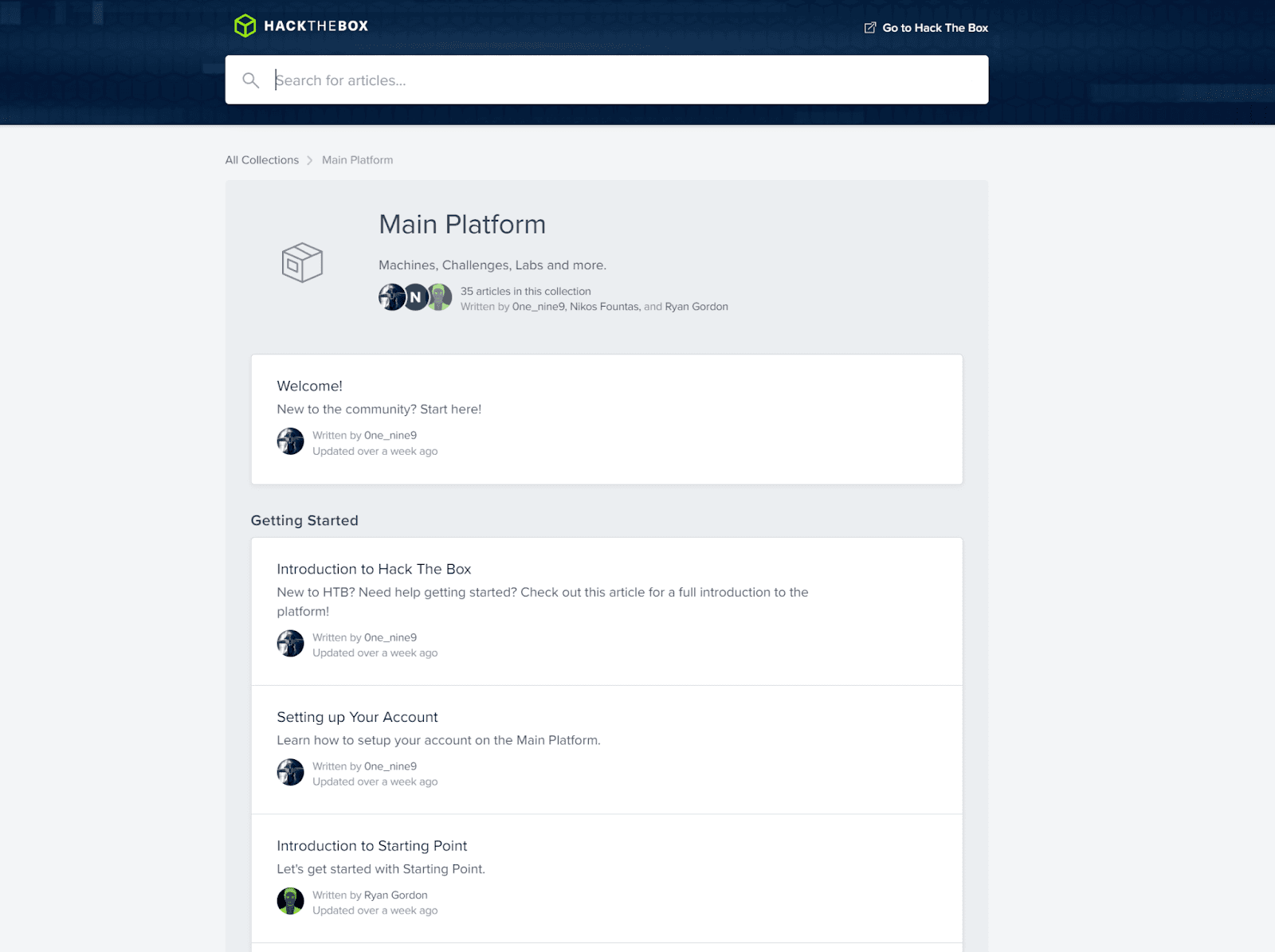
Source: help.hackthebox
The results were pretty impressive. Just by making this knowledge more available via technical documentation, Hack the Box was able to reduce customer churn by 20%.
Hack the Box shows us how companies can prevent losing customers (and revenue) simply by making usage information more available and thus eliminating one of the biggest causes of SaaS churn: users being unable to figure out how to use the product.
Reduces Support Costs
To reiterate an important point from the previous section, SaaS companies need to support their customers through their entire user journey with the product to keep them happy and prevent them from churning from the service.
That means companies need to invest a lot of their resources into channels for customer support, including customer support representatives who help users resolve issues via phone, email, chat, social media, and so on.
This can put a lot of strain on the company’s finances without directly generating revenue.
In fact, depending on their size, companies can spend as much as 10-14% of their revenue on customer support.

Source: SaaS Capital
With everything we’ve said about technical documentation so far, it should already be clear that quality documentation can do a lot to keep this spending on the lower side.
The mechanism is easy to understand.
Suppose a portion of the customers experiencing technical difficulties manages to solve their issues using technical documents (troubleshooting guides, FAQ sections, to name a couple) instead of contacting customer support.
In that case, the costs that would have been incurred to solve those support tickets will never materialize.
But you might protest that creating technical documentation also costs the company money. And you would be right.
However, the cost of solving a customer complaint using documentation is much lower than that of more traditional methods, such as phone or live chat.
That’s because one technical document (such as a troubleshooting article) can help a potentially infinite number of users all at once.
At the same time, a customer support rep needs to solve the same problem individually each time a new user experiences it, incurring a cost every time.
Here’s a comparison of the cost of solving a customer incident by method, just to show you how great that difference in cost really is.
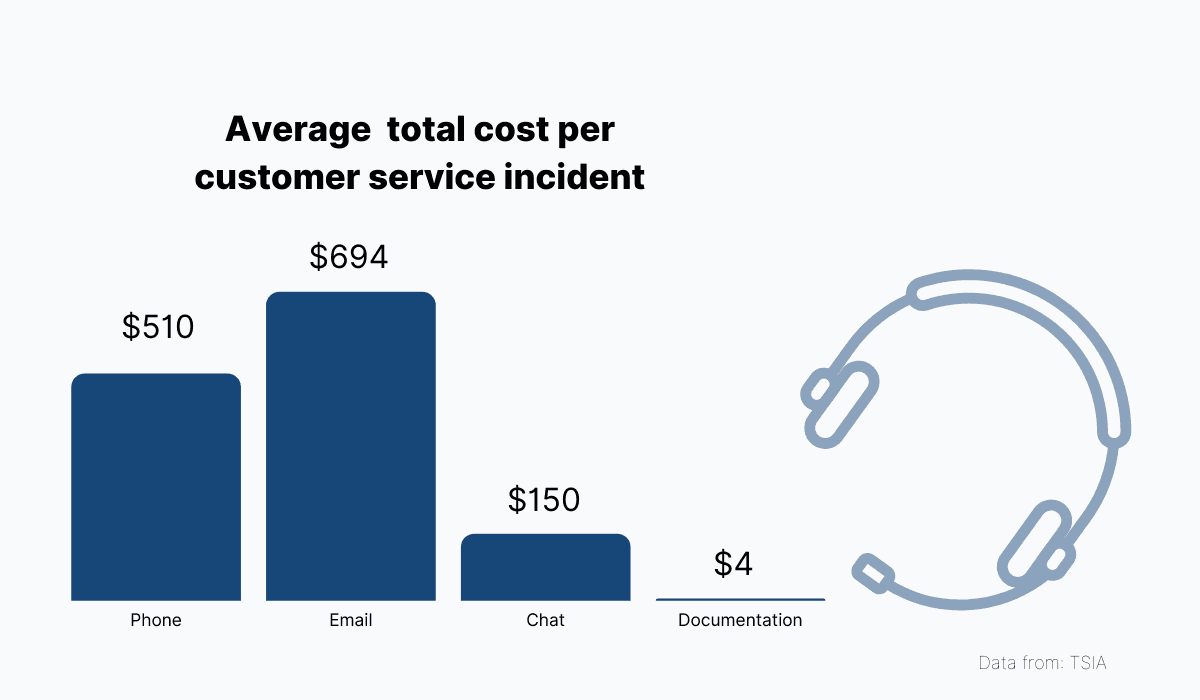
Source: Archbee.com
The key takeaway here is that technical documentation can act as a customer support channel and significantly reduce the workload of your customer support team.
And since every customer support ticket costs money, this is an excellent opportunity to safeguard your finances.
Minimizes Revision Costs
Another threat to your SaaS company’s finances comes from buggy code.
That’s because debugging and fixing errors is a very expensive process that never really ends and only gets more costly as time goes on.
Minimizing revision costs can have a positive impact on a company's finances. Revisions can be costly, both in terms of time and resources. By minimizing the need for revisions, companies can improve their efficiency and reduce costs associated with rework.
Minimizing revision costs can also lead to improved customer satisfaction, which can result in increased customer loyalty and repeat business. Satisfied customers are more likely to recommend the company to others, which can lead to increased revenue through word-of-mouth marketing.
At least, that’s what experienced software engineers, like Eric Goebelbecker, argue:
“Finding and fixing bugs is the single most significant expense in an application’s lifecycle. If your system completes its expected 25-year lifecycle, you’ll spend nearly 50 cents of every dollar isolating and fixing software errors.”
And this is just calculating the direct costs of developer labor in fixing errors. Buggy software also incurs invisible costs, such as:
- Customer loss due to poor user experience.
- Loss of investor trust because delivered products are of poor quality.
- Opportunity loss because fixing these errors can occupy developers so much that they don’t have time to focus on new projects.
The remedy to all of this is to, of course, test the software as much as possible before it hits the market so that a great number of these errors can be eliminated ahead of launch. Testing the software is actually, one of the main role of a technical writer in a company's success!
Technical writers play a key role in this. Their work involves a lot of research, including using the product as a customer would in order to write extensive technical documentation. Here are a few tips for doing research in technical writing.
In other words, technical writers provide an important layer of software testing and bug reporting, which enables the development team to perfect the software ahead of the launch and minimize the need for future revisions.
In fact, experience in software testing is considered to be one of the best backgrounds for people pursuing careers in technical writing, precisely because software testing is such an integral part of a technical writer’s job.

Source: Quora
And since technical writing is often done simultaneously with the software development process, sometimes from the very beginning, it’s likely that errors can be caught and fixed early on.
That’s important because the cost of fixing software errors grows exponentially as the development process goes on and is at its most expensive once the product hits the market.

Source: Raygun
In this way, technical writers play an important part in minimizing software revision costs, which can protect your company’s finances, especially if these revisions are made early on in the project.
Decreases Onboarding Costs
At the beginning of this article, we argued that the demand for new, better software is at an all-time high.
If that’s true, it stands to reason that the demand for software developers to produce that software is even higher.
This is great news for developers, but bad news for companies that need their services.
Developers are now extremely expensive to hire and even more difficult to retain, as there’s always a company offering a better deal.
In fact, statistics show that software developers rarely stay with a company for more than a year or two.

Source: Zippia
The problem with this high turnover rate is that companies are always onboarding and training new developers.
Therefore, they need to keep the onboarding as short and inexpensive as possible.
The best way to do that is to minimize the human element in onboarding.
After all, if senior developers are spending too much time training new developers, they can’t focus on their primary job—developing new products.
And that can put a financial strain on the company.
Thankfully, documentation can help with this situation too.
Have you ever asked what is an internal knowledge base and why your team needs one? Well, knowledge bases aren’t just for external users; they can also be used for internal purposes, such as onboarding.
Companies use knowledge bases to host and share every document a new employee might need, such as policies, procedures, and the company handbook.
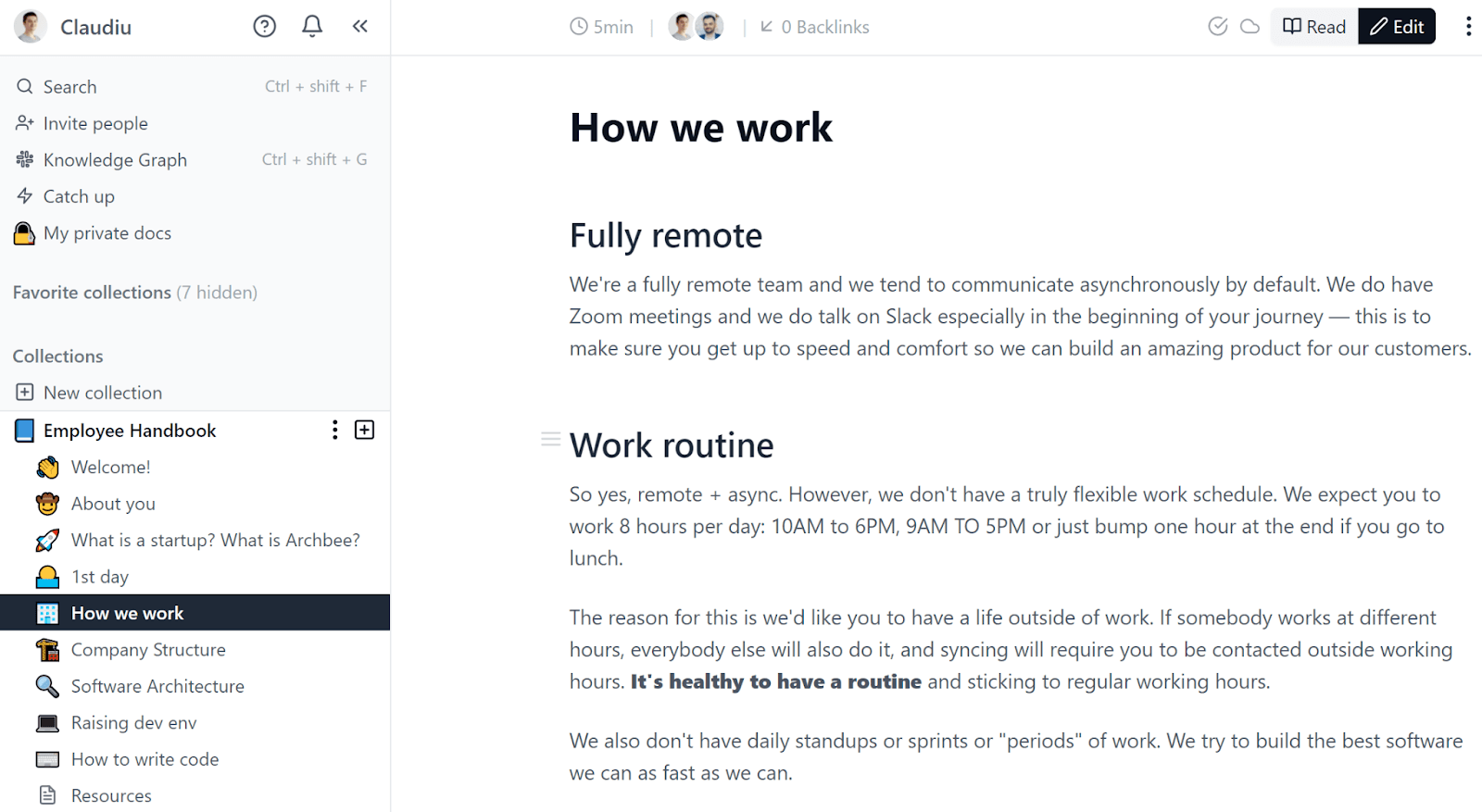
Source: Archbee.com
And if you’re using advanced documentation software, such as Archbee, which enables you to express yourself in all kinds of formats, such as diagrams, multimedia, and even code, you can also create resources for onboarding incoming developers.
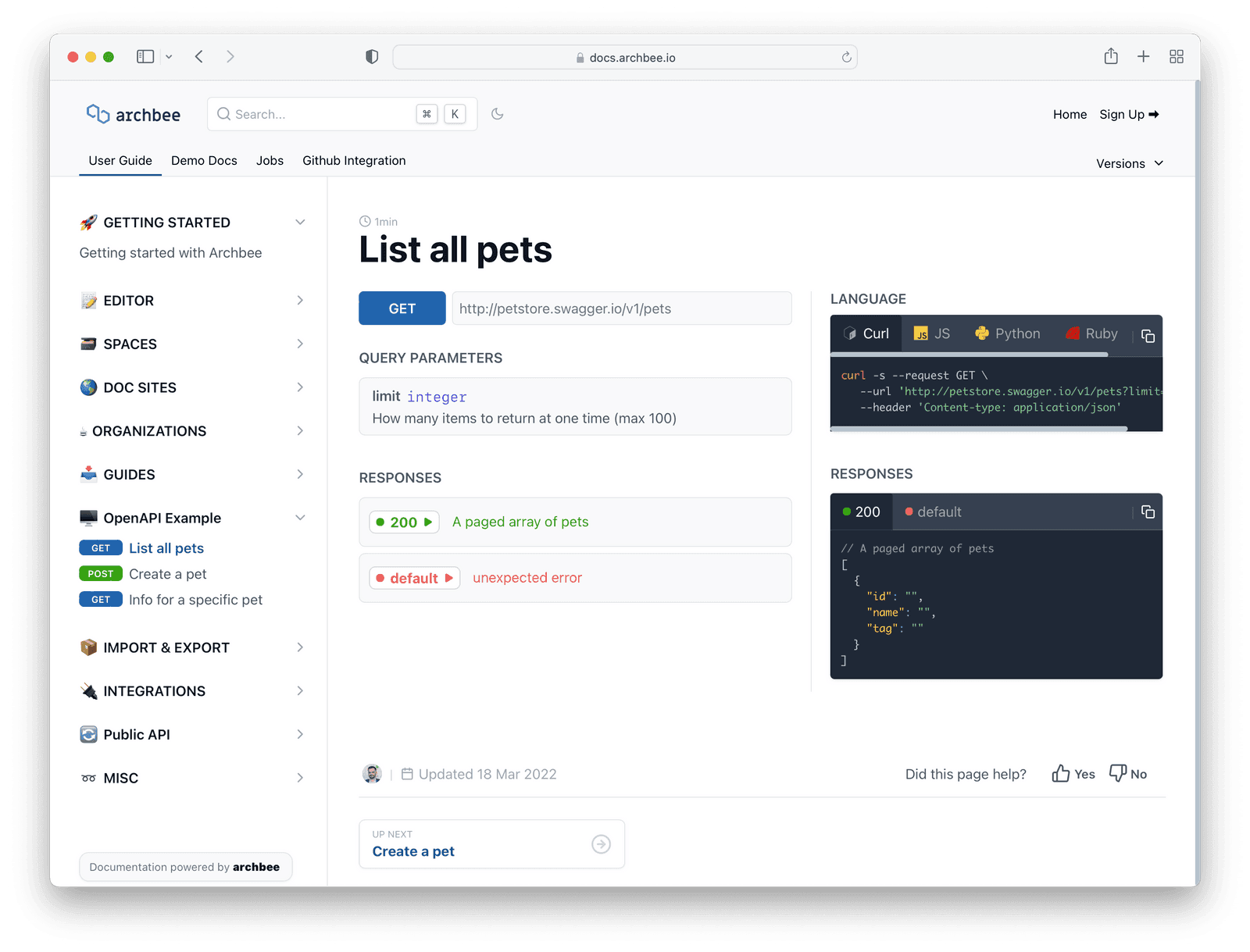
Source: Archbee.com
That’s because s.comuch software will enable you to document the code in your ongoing projects and create a database of comments, explanations, and instructions that your new developers can always access when they feel confused or lost as newcomers to your project.
That way, new developers won’t need as much attention from their supervisors and can become productive in less time, leaving senior developers to concentrate on more important tasks.
This should accelerate projects and decrease the time and resources needed for training and onboarding new developers.
And that’s a great example of how internal documentation can have a positive impact on your company's finances.
Conclusion
There are many ways to impact your company's finances with technical documentation.
From product development to marketing and sales and from software testing to employee onboarding, there’s hardly a department or activity at your company that technical documentation can’t improve and make more efficient.
And with great efficiency and improved systems, you have the opportunity to unlock accelerated growth and a better chance to keep your spending low.
Any way you look at it, technical documentation definitely is beneficial for your company’s finances, so make sure you’re giving it the attention it needs.
FAQ
Frequently Asked Questions
Strong technical documentation boosts revenue and lowers costs across the product lifecycle. It accelerates time to market by freeing developers from writing tasks and clarifying requirements, protecting against the cost of delay. It lifts conversion rates because buyers can self-educate and trust what they see. It improves retention by helping customers reach value faster and avoid churn. It reduces support spend by enabling self-service and deflecting tickets. It cuts revision costs by surfacing issues earlier, when fixes are cheaper. And it shortens onboarding for new hires, so teams become productive sooner. The net effect is more revenue realized with fewer operating costs.



